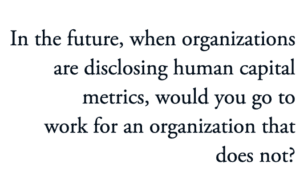 The U.S. Securities and Exchange Commission proposed their first rule for human capital reporting one year ago in August 2019. The comment period closed in October. No final rule has been issued yet, in part likely due to the SEC’s need to address more pressing COVID-related issues. Hopefully, the final rule will be issued during the next 12 months.
The U.S. Securities and Exchange Commission proposed their first rule for human capital reporting one year ago in August 2019. The comment period closed in October. No final rule has been issued yet, in part likely due to the SEC’s need to address more pressing COVID-related issues. Hopefully, the final rule will be issued during the next 12 months.
For those not familiar with the SEC initiative, their proposed rule would apply to all publicly traded U.S. companies. Today, companies have to report only one human capital metric: number of employees. The SEC prescribes 11 other areas for companies to comment on publicly, including products and services, order backlog, raw material sourcing and more. Under the proposed rule, the SEC will no longer prescribe what must be disclosed. Instead, the rule will require all material information to be disclosed. Material means anything that an investor would want to know before buying or selling a stock, bond or derivative.
The SEC does say, however, that since human capital is now the primary driver of value, the disclosure will have to include human capital metrics and commentary about human capital initiatives. In particular, they comment that companies will need to discuss talent acquisition, development and retention, at a minimum.
What will investors want to know? If you were considering buying stock in a company, wouldn’t you want to know about the culture (engagement and leadership survey results), diversity companywide and at the top, time to fill critical positions, leadership bench strength, turnover (especially for critical positions), the prevalence of compliance training, and employee development (average hours, amount spent)?
What will happen if a company does not disclose? First, the SEC may bring enforcement action, resulting in a fine. More important, though, the company risks a shareowner lawsuit for failure to disclose material information. Suppose you paid $100 per share and the stock price subsequently declines to $60. You discover that the culture is terrible, the turnover rate is high, critical positions remain unfilled, the company  cannot hire good talent and it is not investing in its people. If you had known these things, you would not have paid $100 per share. You sue for the $40 loss based on the company’s withholding of material information, just as you would if the company did not disclose material production or sourcing issues.
cannot hire good talent and it is not investing in its people. If you had known these things, you would not have paid $100 per share. You sue for the $40 loss based on the company’s withholding of material information, just as you would if the company did not disclose material production or sourcing issues.
So, how can U.S. companies limit their risk of SEC action or shareowner lawsuit? We think one way would be to adopt the International Organization for Standardization standards released in December 2018. The ISO launched an effort in 2015 to identify and define key metrics from both an investor and employee point of view. So, while the SEC focused just on investors, ISO also focused on what employees would want to know about an organization and what management should know to best manage their human capital.
This effort concluded in 2018 with a list of 59 recommended metrics. Twenty-three are recommended for public disclosure by large organizations. Ten are recommended for public disclosure by small/medium organizations. The 10 recommended for public disclosure by all include total workforce cost, human capital ROI, turnover rate, development and training cost, percentage of employees who have completed compliance training, number of accidents, number killed during work, number of employees, number of full-time equivalents and revenue per employee. The first five metrics are generally not reported today and considered confidential. Number of accidents and those killed may be reported. Number of employees is generally reported today (the one metric required by the SEC), FTEs may not be, and revenue per employee can be calculated today from revenue and number of employees.
So, not all 10 are new in terms of public disclosure, but the first five are. Is your organization ready to disclose workforce cost, amount spent on training, human capital ROI, turnover rate or percentage who have completed compliance training? Are you even tracking these?
If you work for a large organization, some of the additional 13 metrics include diversity by age, gender and disability, diversity of the leadership team, leadership trust, time to fill positions, and percentage of positions filled internally. Beginning to get a sense of how big a deal this is?
True, the ISO recommendations are just that — recommendations. But they will be the natural starting point for any organization that wants to be best-in-class and for U.S. organizations that want to comply with the SEC’s rule. Many of us in the standard-setting space believe that the ISO recommendations will eventually be broadly adopted by all organizations, if not out of the desire to be the most forthcoming, then out of the need to be competitive in the market for investment capital and human capital.
In the future, when organizations are disclosing human capital metrics, would you go to work for an organization that does not? True, they may not be required by law to disclose, but why wouldn’t they disclose at least key metrics voluntarily? Probably because they are an embarrassment. Why would you work for an organization where the culture is terrible, where they don’t invest in you, where turnover is high and where there are not enough employees to do the work?
Today, you can say you didn’t know. Tomorrow, you will know.
The proposed SEC rule is available here. The rule is 116 pages, but the section on human capital is under section IIB7, pages 44-54.
The ISO document (ISO 30414:2018 Human resource management — Guidelines for internal and external human capital reporting) is available for purchase here for CHF138 ($140).
Note: ISO is just beginning to release technical specifications on how the metrics are defined and used. By mid-2021, specifications should be available on all 59 metrics. The specifications for five of the eight training and development metrics are now complete and in publication. They should be available soon.














